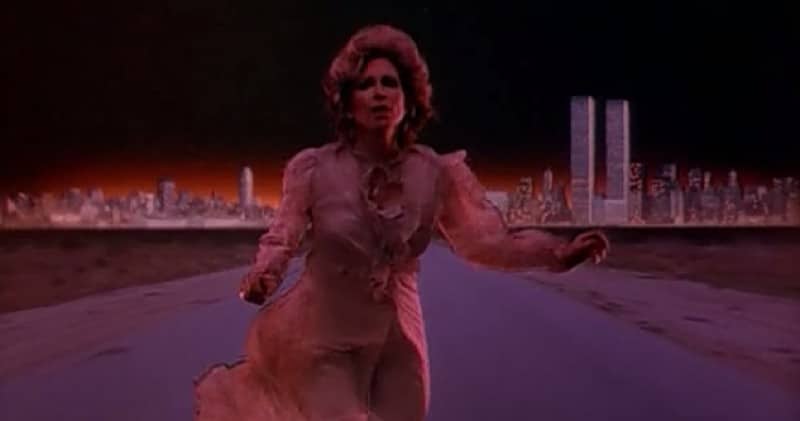The unclaimed ‘Elm Street’ franchise entry.

1984 was a very important year for genre cinema. Apart from heralding the birth of genre’s most ardent (arguably to say the least) fan, yours truly, 1984 was the year that saw the implementation of the PG-13 rating. The newly minted middle ground between PG and R was thrust into being after Indiana Jones and the Temple of Doom (released earlier that same year) traumatized sensitive viewers unprepared for the sight of a man’s still-beating heart being plucked from his chest.
The first movie to be branded with the new PG-13 rating was John Milius’ Red Dawn. Red Dawn is a landmark film in that it represents the pinnacle of Cold War paranoia as reflected in pop culture. The second movie to roll off the studio line with the PG-13 rating was a forgotten sci-fi thriller that, like Temple of Doom, featured actress Kate Capshaw and a still-beating heart ripped from a man’s chest. And yet Dreamscape’s similarity to Temple of Doom is overshadowed by its shared composition with another iconic crowd-pleaser of 1984.
In Dreamscape, Dennis Quaid plays a man with psychic abilities harangued into participating in an experiment wherein he projects himself into the dreams of others in order to solve their deep-seeded psychological issues. At the facility housing the project, there are whispers of a vicious boogeyman stalking patients in their dreams and certain patients actually begin dying as a result of what occurs in those nightmares. If images of a charred Robert Englund aren’t immediately springing to your mind, then you obviously only read the last sentence of this paragraph.
It is true that there is evidently a great deal of parallel thinking that lead to the near simultaneous release of Dreamscape and A Nightmare on Elm Street, but obviously the proximity of opening dates precludes accusations of foul play. What is interesting however is how “Freddy Krueger-y” Dreamscape’s antagonist becomes as the film progresses; taking on multiple fantastical forms to slash and terrify dreamers to death. Further interesting in the fact that Dennis Quaid projects himself into the subconscious of a young boy to help him face his boogeyman head-on in the dream world ‐ taking the fight to the monster ‐ which calls to mind the central conceit of A Nightmare on Elm Street 3: Dream Warriors.
We, the hosts of the Junkfood Cinema podcast, are convinced that without Dreamscape, we would have no Dream Warriors. Sure, there would inevitably have been a third Freddy movie, the box office grosses would have seen to that, but the structure and plot would have been very different. Before you sharpen your keyboard fingers to condemn this assertion as a wild stretch, bear in mind that Dreamscape was co-written by screenwriter Chuck Russell…who three years later co-wrote and directed A Nightmare on Elm Street 3: Dream Warriors.
The influence of Dreamscape is not limited to the Elm Street franchise. The fabricated science of logistically entering another person’s dream is entirely reminiscent of Christopher Nolan’s Inception. Like the Nolan brothers, the writers of Dreamscape utilize dubious technology in an attempt to wrangle something so fantastical as to be akin to magic so that there is at least the illusion of a realistic foundation. Like Inception, Dreamscape also applies nightmare imagery archetypes to build its set pieces and drive its mechanics. The feeling of falling in a dream, for example, is something plucked from the collective unconscious and inserted into both films.
As a fine point to place on the parallel thinking that found Dreamscape released alongside some of its contemporaries as well as its story components that may have influenced modern classics, remember Red Dawn? The first movie slapped with a PG-13 rating after the sensation caused by Temple of Doom? In Dreamscape, one of the archetypal nightmare scenarios is the end of the world, which is bundled with the shared dream experience of a loved one in peril as we watch helplessly. The nuclear holocaust witnessed by The President in Dreamscape forces him to propose a disarmament pact with Russia during the height of the Cold War; compelling sinister forces, who see disarmament as the first step to annihilation, to plot a dream assassination. Dreamscape internalizes the Cold War panic that Red Dawn exaggeratedly externalized.
For more dream(scape) analysis, wake up and download the latest episode of Junkfood Cinema! Rest assured, it’s a good one.
As a special treat, anyone who backs JFC on Patreon will have access to a weekly bonus episodes covering an additional cult movie, a new movie in theaters, or a mailbag episode devoted to your submitted questions! Have a couple bucks to throw in the hat, we’ll reward you!
On This Week’s Show:
- Appetizers [0:00–2:39]
- The Main Course[2:40–51:07]
- The Junkfood Pairing[51:08–54:36]
Follow the Show:
Related Topics: Horror, Junkfood Cinema, Podcast
